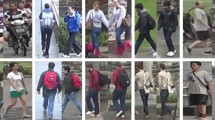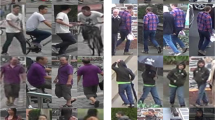Abstract
Person re-identification aims to identify the same person across different cameras, which is widely applied in the intelligent monitoring field. The research of TriHard loss has been verified to improve performance efficiently in the person re-identification task. However, TriHard loss considers the hardest positive sample and the hardest negative sample exclusively, which ignores the remaining samples. To stuff this gap, we propose an expansion-pool TriHard (TriEP) loss which can give attention to the hardest samples and other samples. Initially, the equal-label sample pools are expanded based on the labels of the hardest samples. Then, the statistics of the sample pool are calculated according to the distribution of samples. Finally, the dynamic penalty is imposed on TriHard loss to construct TriEP loss. Extensive experiments on Market-1501, DukeMTMC, and occluded datasets prove the superiority of the proposed TriEP loss. Compared with the baseline model, a noticeable performance improvement can be obtained after embedding the proposed TriEP loss.







Similar content being viewed by others
References
Geng M, Wang Y, Xiang T, Tian Y (2016) Deep transfer learning for person re-identification. arXiv preprint arXiv:1611.05244
Lin Y, Zheng L, Zheng Z, Wu Y, Hu Z, Yan C, Yang Y (2019) Improving person re-identification by attribute and identity learning. Pattern Recognit 95:151–161
Li D, Wei X, Hong X, Gong Y (2020) Infrared-visible cross-modal person re-identification with an x modality. In: Proceedings of IEEE AAAI. pp 4610–4617
Huang Z, Qin W, Luo F, Guan T, Xie F, Han S, Sun D (2021) Combination of validity aggregation and multi-scale feature for person re-identification. J Ambient Intell Humaniz Comput. https://doi.org/10.1007/s12652-021-03473-6
Zheng X, Luo H, Fan X, Xiang W, Jian S (2017) Alignedreid: surpassing human-level performance in person re-identification. arXiv preprint arXiv:1711.08184
Wei L, Zhang S, Yao H, Gao W, Tian Q (2019) Glad: global-local-alignment descriptor for pedestrian retrieval. IEEE Trans Multimed 21(4):986–999
Li D, Chen X, Zhang Z, Huang K (2017) Learning deep context-aware features over body and latent parts for person re-identification. In: Proceedings of IEEE CVPR. pp 7398–7407
Li W, Zhao R, Xiao T, Wang X (2014) Deepreid: deep filter pairing neural network for person re-identification. In: Proceedings of IEEE CVPR. pp 152–159
Ustinova E, Ganin Y, Lempitsky V (2017) Multi-region bilinear convolutional neural networks for person re-identification. In: Proceedings of IEEE AVSBS. pp 1–6
Cheng D, Gong Y, Zhou S, Wang J, Zheng N (2016) Person re-identification by multi-channel parts-based cnn with improved triplet loss function. In: Proceedings of IEEE CVPR. pp 1335–1344
Din S, Lin L, Chao H, Wang G (2015) Deep feature learning with relative distance comparison for person re-identification. Pattern Recognit 48(10):2993–3003
Hermans A, Beyer L, Leibe B (2017) In defense of the triplet loss for person re-identification. arXiv preprint arXiv:1703.07737
Gray D, Tao H (2008) Viewpoint invariant pedestrian recognition with an ensemble of localized features. In: Proceedings of ECCV, pp 262–275
Li Z, Chang S, Liang F, Huang T, Cao L, Smith J (2013) Learning locally-adaptive decision functions for person verification. In: Proceedings of IEEE CVPR. pp 3610–3617
Cheng D, Cristani M, Stoppa M, Bazzani L, Murino V (2011) Custom pictorial structures for re-identification. In: Proceedings of BMVC. pp 1–11
Wang X, Yang M, Zhu S, Lin Y (2015) Regionlets for generic object detection. IEEE Trans Pattern Anal Mach Intell 37(10):2071–2084
Liao S, Hu Y, Zhu X, Li S (2015) Person re-identification by local maximal occurrence representation and metric learning. In: Proceedings of IEEE CVPR. pp 2197–2206
Weinberger K, Saul L (2009) Distance metric learning for large margin nearest neighbor classification. J Mach Learn Res 10(12):207–244
Brockmeier J, Giraldo L, Emigh M, Bae J, Principe J (2013) Information-theoretic metric learning: 2-d linear projections of neural data for visualization. In: Proceedings of IEEE EMBS. pp 5586–5589
Kostinger M, Hirzer M, Wohlhart P (2012) Large scale metric learning from equivalence constraints. In: Proceedings of IEEE CVPR. pp 2288–2295
Pedagadi S, Orwell J, Velastin S, Boghossian B (2013) Local fisher discriminant analysis for pedestrian re-identification. In: Proceedings of IEEE CVPR. pp 3318–3325
Su C, Li J, Zhang S, Xing J, Gao W, Tian Q (2017) Pose-driven deep convolutional model for person re-identification. In: Proceedings of IEEE ICCV. pp 3980–3989
Liu X, Zhao H, Tian M, Sheng L, Shao J, Yi S, Yan J, Wang X (2017) Hydraplus-net: attentive deep features for pedestrian analysis. In: Proceedings of IEEE ICCV. pp 350–359
Sun Y, Zheng L, Yang Y, Wang S, Tian Q (2018) Beyond part models: person retrieval with refined part pooling (and a strong convolutional baseline). In: Proceedings of IEEE ECCV. pp 501–518
Schroff F, Kalenichenko D, Philbin J (2015) Facenet: a unified embedding for face recognition and clustering. In: Proceedings of IEEE CVPR. pp 845–853
Marín-Reyes PA, Marra M, Lorenzo-Navarro J, Santana MC (2019) Averobot: an audio-visual dataset for people re-identification and verification in human-robot interaction. In: Proceedings of international conference on pattern recognition applications and methods. pp 255–265
Chen W, Chen X, Zhang J, Huang K (2017) Beyond triplet loss: a deep quadruplet network for person re-identification. In: Proceedings of IEEE CVPR. pp 1320–1329
Xiao Q, Luo H, Zhang C (2017) Margin sample mining loss: a deep learning based method for person re-identification. arXiv preprint arXiv:1710.00478
Zhao C, Lv X, Zuo W, Miao D (2020) Deep fusion feature representation learning with hard mining center-triplet loss for person re-identification. IEEE Trans Multimed 99:1
Lv X, Zhao C, Chen W (2019) A novel hard mining center-triplet loss for person re-identification. In: Proceedings of Chinese conference on pattern recognition and computer vision. pp 199–210
Liu H, Tan X, Zhou X (2020) Parameters sharing exploration and hetero-center based triplet loss for visible-thermal person re-identification. arXiv preprint arXiv:2008.06223
Si T, Zhang Z, Liu S (2019) Compact triplet loss for person re-identification in camera sensor networks. Ad Hoc Netw 95(11):1–8
Luo H, Gu Y, Liao X, Lai S, Jiang W (2019) Bag of tricks and a strong baseline for deep person re-identification. In: Proceedings of IEEE CVPR. pp 1487–1495
Zhong Z, Zheng L, Kang G, Li S, Yang Y (2017) Random erasing data augmentation. arXiv preprint arXiv:1708.04896
Fan X, Jiang W, Luo H, Fei M (2018) Spherereid: deep hypersphere manifold embedding for person re-identification. arXiv preprint arXiv:1807.00537
Zheng Z, Zheng L, Yang Y (2016) A discriminatively learned cnn embedding for person re-identification. ACM Trans Multimed Comput Commun Appl 14(1):1–20
Zheng L, Shen L, Tian L, Wang S, Wang J, Tian Q (2015) Scalable person re-identification: a benchmark. In: Proceedings of IEEE ICCV. pp 1116–1124
Ristani E, Solera F, Zou R, Cucchiara R, Tomasi C (2016) Performance measures and a data set for multi-target, multicamera tracking. In: Proceedings of IEEE ICCV. pp 17–35
Miao J, Wu Y, Liu P, Ding Y, Yang Y (2019) Pose-guided feature alignment for occluded person re-identification. In: Proceedings of IEEE ICCV. pp 542–551
Zheng W, Gong S, Xiang T (2011) Person re-identification by probabilistic relative distance comparison. In: Proceedings of IEEE CVPR. pp 649–656
Sun Y, Xu Q, Li Y, Zhang C, Li Y, Wang S, Sun J (2019) Perceive where to focus: learning visibility-aware part-level features for partial person reidentification. In: Proceedings of IEEE CVPR. pp 393–402
Tay C, Roy S, Yap K (2019) Aanet: attribute attention network for person re-identifications. In: Proceedings of IEEE CVPR. pp 7127–7136
Zhuang Z, Wei L, Xie L, Zhang T, Zhang H, Wu H, Ai H, Tian Q (2020) Rethinking the Distribution Gap of Person Re-identification with Camera-Based Batch Normalization. In: Proceedings of IEEE ECCV. pp 140–157
Hou R, Ma B, Chang H, Gu X, Shan S, Chen X (2019) Interaction-and-aggregation network for person re-identification. In: Proceedings of IEEE CVPR. pp 9309–9318
Zhou K, Yang Y, Cavallaro A, Xiang T (2019) Omni-scale feature learning for person re-identification. In: Proceedings of IEEE ICCV. pp 3701–3711
Quan R, Dong X, Wu Y, Zhu L, Yang Y (2019) Auto-reid: searching for a part-aware convnet for person re-identification. In: Proceedings of IEEE ICCV. pp 3749–3758
Zheng Z, Yang X, Yu Z, Zheng L, Yang Y, Kautz J (2019) Joint discriminative and generative learning for person re-identification. In: Proceedings of IEEE CVPR. pp 2133–2142
Dai Z, Chen M, Gu X, Zhu S, Tan P (2019) Batch dropblock network for person re-identification and beyond. In: Proceedings of IEEE ICCV. pp 3690–3700
Fan X, Jiang W, Luo H, Fei M (2019) Spherereid: Deep hypersphere manifold embedding for person re-identification. J Vis Commun Image Rep 60:51–58
He L, Liang J, Li H, Sun Z (2018) Deep spatial feature reconstruction for partial person re-identification: alignment-free approach. In: Proceedings of IEEE CVPR, pp 7073–7082
He L, Sun Z, Zhu Y, Wang Y (2018) Recognizing partial biometric patterns. arXiv preprint arXiv:1810.07399
Miao J, Wu Y, Yang Y (2021) Identifying visible parts via pose estimation for occluded person re-identification. IEEE Trans Neural Netw Learn Syst. https://doi.org/10.1109/TNNLS.2021.3059515
Wang G, Yang S, Liu H, Wang Z, Yang Y, Wang S, Yu G, Zhou E, Sun J (2020) High-order information matters: learning relation and topology for occluded person re-identification. In: Proceedings of IEEE CVPR. pp 6448–6457
Zhang X, Yan Y, Xue J, Hua Y, Wang H (2020) Semantic-aware occlusion-robust network for occluded person re-identification. IEEE Trans Circ Syst Video Technol 31(7):2764–2778
Author information
Authors and Affiliations
Corresponding author
Additional information
Publisher's Note
Springer Nature remains neutral with regard to jurisdictional claims in published maps and institutional affiliations.
Rights and permissions
About this article
Cite this article
Yu, Z., Qin, W., Tahsin, L. et al. TriEP: Expansion-Pool TriHard Loss for Person Re-Identification. Neural Process Lett 54, 2413–2432 (2022). https://doi.org/10.1007/s11063-021-10736-y
Accepted:
Published:
Issue Date:
DOI: https://doi.org/10.1007/s11063-021-10736-y




